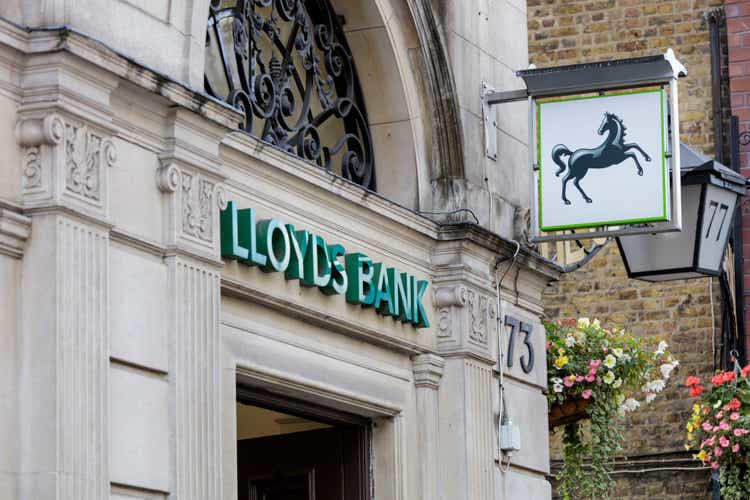petekarici
Overview
Lloyds Banking Group (NYSE:LYG) is a British financial institution formed through the acquisition of HBOS by Lloyds TSB in 2009.
It is one of the UK’s largest financial services organizations, with more than 30 million customers (about the population of Texas). Alongside Barclays, NatWest and HSBC, it is one of the Big Four banks in the UK.
LYG as an interest rate play
LYG is an interesting play on rocketing interest rates as the Bank of England tries to tame a 40-year high inflation rate.
Following the “mini-budget” announcement, markets are betting on interest rates to peak at 6% in the UK which will create a massive bonanza for high street lenders such as LYG.
As of 30 June 2022, LYG had £145.9 billion of LCR eligible assets with £78.3 billion held as central bank reserves.
Each additional 25 basis point rise is expected to add close to £200 million in treasury income for LYG solely from holding cash with the Bank of England.
Imperfect pass-through on customer deposits
The Big Four banks have failed to pass on their gains from a rising Bank Rate to savers. The Bank of England increased the Bank Rate to 2.25% last month.
However, LYG pays a meagre 0.40% on its main instant access savings account, while Barclays (BCS) pays 0.15% on its everyday easy access savings account.
This imperfect pass-through allows the Big Four banks to improve their Net Interest Income (NII) in a rising rate environment.
In simple terms, NII is the difference between what a bank pays for deposits and what it earns from loans.
The Big Four have benefited from low-cost sticky retail deposits historically.
By contrast, Yorkshire Building Society and Chase UK, JP Morgan’s digital bank, have been paying interest rates above 1.5% p.a.
However, regional banks and FinTech’s have struggled to take deposit market share from the Big Four due to the perception of being less safe than the traditional banks.
LYG vs BCS: NII sensitivity
LYG is one of the most interest rate sensitive banks in the UK Big Four. For the sake of analysis, I will compare the interest rate sensitivity of LYG and Barclays.
In their latest trading update, LYG and BCS provided their NII sensitivity to the market. The numbers are as follows:
|
Interest rate sensitivity (£m) (+25bps) |
Year 1 |
Year 2 |
Year 3 |
|
Lloyds Bank |
175 |
250 |
375 |
|
Barclays |
225 |
375 |
525 |
To allow comparison, we can calculate the NII gains for each bank as a proportion of their balance sheet size.
As of 30 June 2022, Barclays reported total assets of nearly £1.6 trillion against £890 billion for LYG.
Despite a balance sheet nearly twice the size of LYG, Barclays NII gains are relatively modest and represent a smaller portion of its balance sheet size.
LYG benefits from higher NII sensitivity due to its funding composition and business model.
LYG’s business activities is funded primarily by customer deposits compared to BCS where customer deposits represent only 34% of total funding.
|
As at 30/06/22 |
Customer deposits (£m) |
Total funding (£m) |
Customer deposits as a % of total funding |
|
Lloyds Bank |
478,200 |
674,200 |
70.93% |
|
Barclays |
538,779 |
1,589,000 |
33.91% |
Due to the imperfect pass-through on customer deposits (discussed above), LYG is more NII sensitive than BCS.
This is because wholesale funding tends to re-price quicker than retail funding.
Additionally, BCS has an investment bank and LYG does not. BCS cannot use customer deposits to fund its investment banking activities due to UK ring-fencing regulations.
Hence BCS is reliant on wholesale funding for its investment banking activities.
However, the investment bank is not all bad. It has been a great source of income diversification for BCS in recent years.
LYG on the other hand is more reliant on customer deposits to fund its activities.
An undiversified funding composition can be a source of risk for LYG but it provides better NII sensitivity in the current environment.
Conclusion
I believe that LYG is a great buying opportunity at the current share price. It is one of the most interest rate sensitive Big Four bank due to its funding composition and will benefit from a rising rate environment.


Be the first to comment